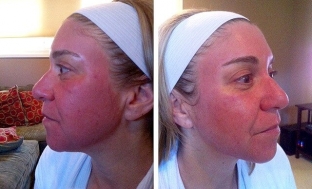Skin response to chemical peels of various depths can be as expected – in the form of an immediate inflammatory process and subsequent renewal of the skin and unwanted – in the form of side effects. Complications from peeling can develop immediately – in the first few days after the procedure, & nbsp; as well as during the regeneration period after two weeks and later. What actions should be taken if an adverse reaction to a chemical peel develops, read on estet-portal.com.
- Immediate adverse reactions after chemical peels
- Complications after chemical peeling during skin regeneration
Immediate side effects after chemical peels

In the first 3—7 days after a chemical peel, a number of adverse skin reactions to the procedure may occur, which are considered complications and require active therapeutic measures.
Follow us on Instagram!
- Infection. It happens most often due to non-compliance with aseptic and antiseptic measures during the procedure or in the period after peeling. The patient is prescribed local antibiotic therapy: a good effect is given by ointment baneocin, oxycort, in severe cases – systemically kefzol, tavanic.
- Allergy. It can be provoked by kojic acid, ascorbic acid in the composition of the peeling solution, as well as components of cosmetic products for post-peeling care. It is manifested by increasing hyperemia, severe itching, if edema also joins – dexamethasone or prednisolone, antihistamines should be administered immediately intramuscularly.
- Herpes. It is observed most often after peeling with retinoids (sprinkling the red border of the lips and wings of the nose) or with trichloroacetic acid at a concentration of 25-30% (generalized rashes are likely). The danger of such an adverse skin reaction is that the risk of atrophic and even hypertrophic scars increases. For prevention, it is recommended to conduct a course of antiherpetic therapy before the procedure of median or deep peeling, even if the patient does not remember when he last had an exacerbation of herpes. If the complication nevertheless happened – pulse therapy with acyclovir 1g/day is prescribed once for 5 days.
- Persistent erythema. The reaction of the skin to peeling is interpreted as extremely unfavorable, when inflammation and swelling persist for more than 3 days – this usually means that the damaging effect of the peeling was stronger than the regenerative capabilities of the skin. This condition is dangerous in that degenerative changes can develop in the skin, its elasticity decreases and sensitivity increases. The therapy should be very active – with the use of antioxidants and anti-inflammatory drugs with zinc content, indomethacin, voltaren, topical non-fluorinated steroids are recommended.
Read also: The most unpleasant complications after chemical peeling and their consequences
It is very important to correctly assess the reparative reserves of the skin and the condition of the vessels, take into account the skin type, and collect a detailed patient history before performing a chemical peel. this will prevent the listed complications.
Complications after chemical peeling during skin regeneration
Some complications after chemical peels, especially medium and deep ones, manifest in the period from 2 to 6 weeks, when active regenerative processes begin in the skin.
Careful selection of patients for peeling, very careful and meticulous history taking can avoid many complications or at least significantly reduce the risk of unpleasant consequences after them.
Persistent erythema. At risk patients with telangiectasias. Persistent erythema always tends to self-regress even without drug therapy, but, nevertheless, spoils the life of patients for six months, and sometimes longer.
Read also: Phenol peeling: composition and application features
Microcurrent therapy gives a good therapeutic effect, which can be started almost in the first days after peeling. It may be recommended to apply a 1% solution of epinephrine hydrochloride (0.5 ml \ 100 ml of distilled water) to the skin – it quickly reduces the severity of erythema and calms the patient.
Hyperpigmentation. Triggered by the skin's inflammatory response to peeling, which stimulates increased production of mellanocyte-stimulating hormone. Another provoking factor for hyperpigmentation can be physiotherapy in the period after peeling.
Read also: Case report: complications after phenol peeling in the periorbital area
Patients with a tendency to hyperpigmentation or with IV-V skin phototype are at risk. Therapeutic measures: mesotherapy with ascorbic acid preparations (10-20%), additionally retinoic peeling (2-5%) or combined with a combination of kojic and glycolic acids.

Post-peel acne. It is provoked by an inflammatory reaction of the skin, which activates sebocytes. At risk are patients with oily skin, seborrhea and a history of pubertal acne.
If inflamed acne elements appear, therapy with sebosuppressors, local and systemic antibacterial treatment is carried out. Sometimes just a dynamic observation is enough, since the excess sebum secretion disappears on its own after 2-3 months.
More interesting stuff on our YouTube channel:







Add a comment